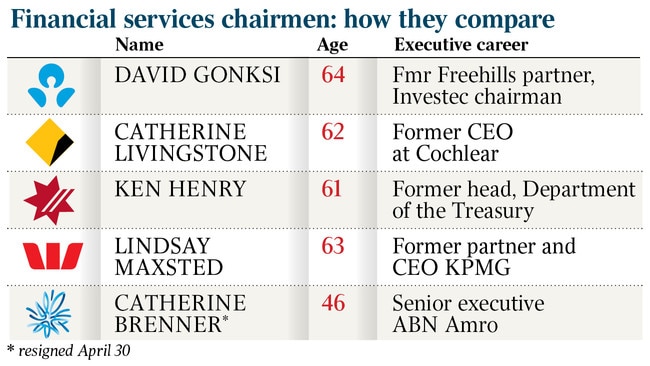Directors reject idea gender quota behind AMP, bank failures
Elizabeth Proust denies a push for more women on boards has led to inexperienced women being promoted too early.

Australian Institute of Company Directors chairwoman Elizabeth Proust has rejected suggestions that the push for more women on boards has led to women without senior corporate experience getting senior board roles, including directorships at AMP.
In an interview with The Australian yesterday, Ms Proust also rejected suggestions that the AICD had been too aggressive in pushing ahead with a target of 30 per cent of women on the boards of ASX 200 companies by the end of this year.
She was speaking following comments that former AMP chairwoman Catherine Brenner, who resigned on Monday following focus on her role by the royal commission, did not have the corporate experience to chair a major board such at AMP.
Ms Brenner, 46, who became AMP chairwoman two years ago after the sudden departure of Simon McKeon, is one of the youngest chairs of an ASX 200 company and has not had experience as a chief executive or running a major corporate operation.
CBA chairwoman Catherine Livingstone, 62, is a former chair of Telstra and National Australia Bank. Current NAB chairman Ken Henry, 60, is a former head of the federal Treasury.
Westpac chairman Lindsay Maxsted, 63, is a former chief executive of accounting firm KPMG Australia, and ANZ chairman David Gonski, 64, has had a long experience as a corporate adviser and company director. BHP chairman Ken MacKenzie, 54, is a former chief executive of packing company Amcor.

Ms Proust said: “It’s disappointing that the media, including social media, is responding to issues coming out of the royal commission through a gender lens.
“More than 72 per cent of the ASX 200 directors are men, so why the focus on gender diversity?” Ms Brenner is a former investment banker who is also on the boards of Coca-Cola Amatil and Boral.
Her appointment as AMP chairwoman with little corporate operational experience was seen as a board response to the sudden departure of Mr McKeon, rather than as a well-thought-out process of board renewal as had been the case with other leading corporate chairs.
Ms Proust said the chairs of ASX 200 companies had diverse backgrounds.
“By no means have they all been CEOs of companies in previous careers,” she said. “There is great diversity of background: professional services, the public service, investment banking as well as CEOs.”
The AICD has been a strong supporter of moves to increase the number of women on boards for the past 10 years.
Under Ms Proust, it has joined other groups in pushing for a target of 30 per cent by the end of this year.
The latest figures show that 26.7 per cent of ASX 200 directors are women.
This compares with 25 per cent this time last year and only 8.3 per cent in 2009 when the AICD began tracking the number of women on boards. Ms Proust said the AICD had argued the business case for diversity “to improve decision making, but always in the context of making appropriate appointments”.
She said the royal commission was highlighting systemic issues in financial services, especially on remuneration and accountability.
“Boards and their directors have serious challenges to face from the evidence to date, as does the AICD,” she said.
“The main focus should be on ethics, standards and accountability, not gender politics.”
In a radio interview yesterday, Business Council of Australia chief executive Jennifer Westacott said that there was a need to look at situations where there were a number of people “on the same board, over and over again”.
She said boards needed to “look at their composition” to see if they had the right people sitting around the board table and whether they were doing enough questioning of the information they were being given by management teams.
She said this should lead to discussions around board tables about whether there was a need for fresh blood on a board, or younger people or people with different backgrounds.
Australian Shareholders’ Association director Allan Goldin yesterday said the ASA supported the call for having women make up 30 per cent of the boards of major companies. But he said this did not stop the ASA recently calling for Ms Brenner’s resignation.
He said the ASA would argue against the re-election of two other women directors and the appointment of one male director to AMP when it meets next week.
Mr Goldin said the ASA’s support for having women make up 30 per cent of company boards did not mean women who were not up to the job should be appointed.
“The last thing you want is people being put on a board because they are part of a group who should be on a board,” he said.
He said there was “positive discrimination” happening in corporate Australia as corporate leaders looked to promote more women into senior ranks.
“It is positive discrimination but we don’t think it is a bad thing,” he said.
Mr Goldin said the ASA was “gender neutral” on AMP.
He said Ms Livingstone had taken a proactive stance on changing CBA and was a “capable chairman”.
“At AMP we had a chairman who hadn’t demonstrated the same sort of capability,” he said.
“Our calling for Catherine Brenner to step down, as we did 10 days ago, is the normal thing we would do when someone is coming up for an election.”
Company director and immediate past president of Chief Executive Women, Diane Smith-Gander, said suggestions the push towards having 30 per cent women on boards had led to some of the problems highlighted by the royal commission was “an extraordinary slur on the extraordinary pool of highly qualified and experienced directors”.
“I completely reject any suggestion that the push to 30 per cent board representation in the ASX200 has contributed to the failures uncovered at AMP,” she said. “When seeds are sown over an extended period it is not credible to try and blame the outcomes on very recent events.
“I have yet to see any evidence that the pool of qualified women able to take up board seats in Australia is insufficient to meet a 30 per cent representation on the ASX 200.”






To join the conversation, please log in. Don't have an account? Register
Join the conversation, you are commenting as Logout